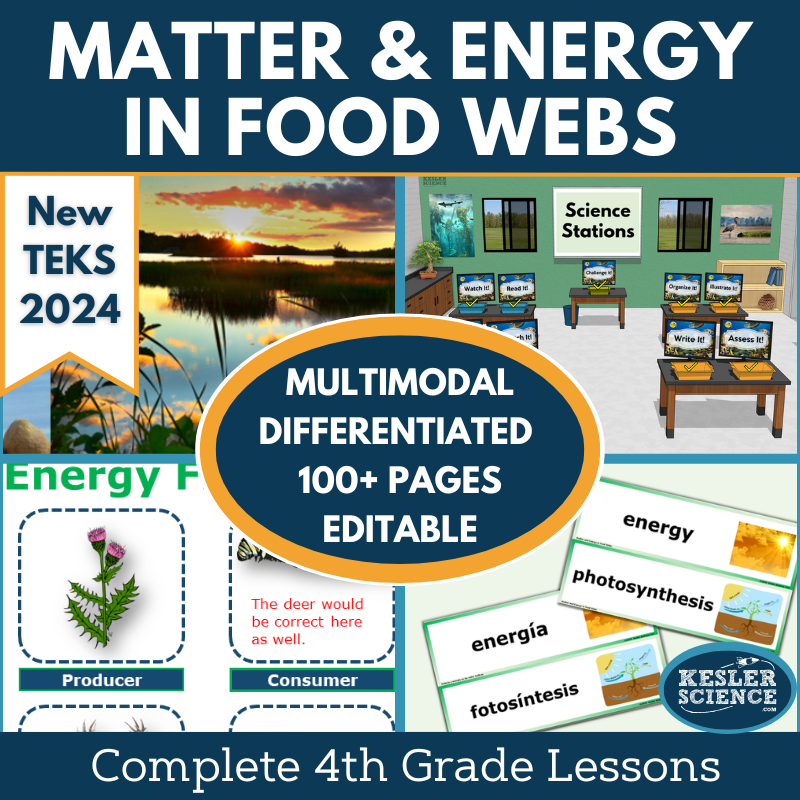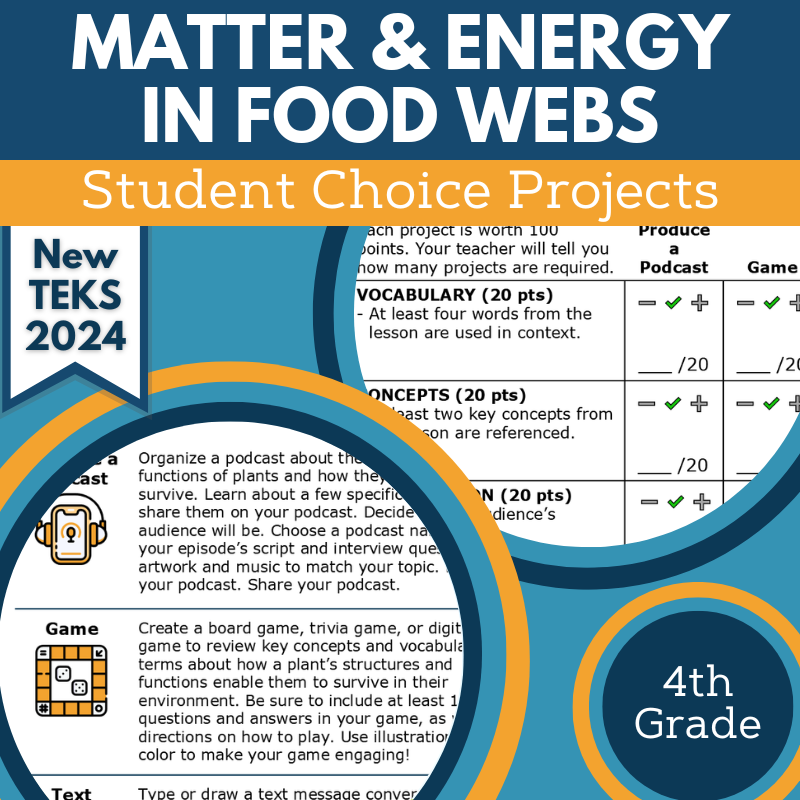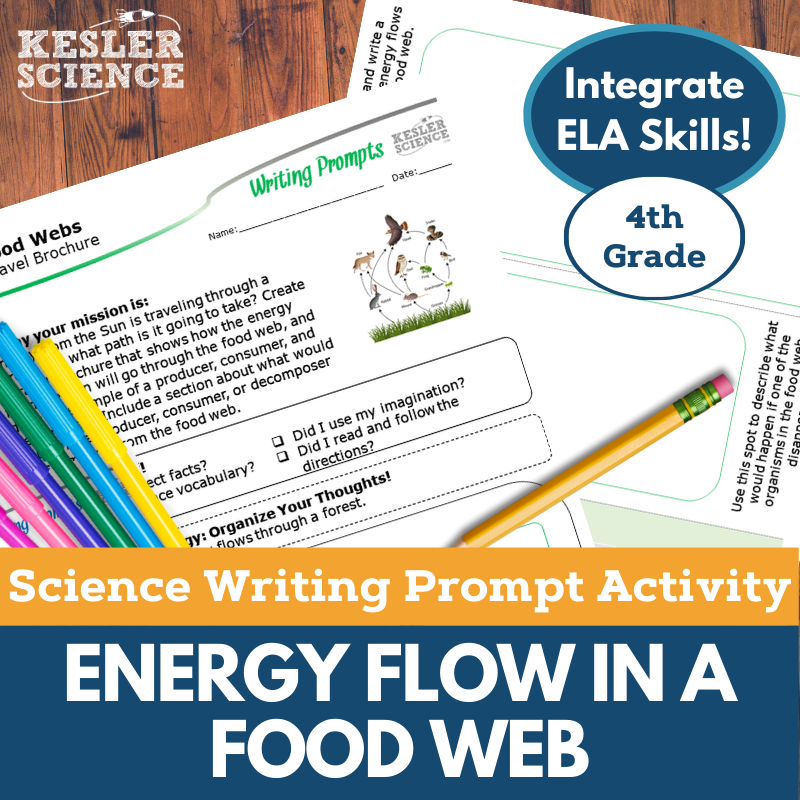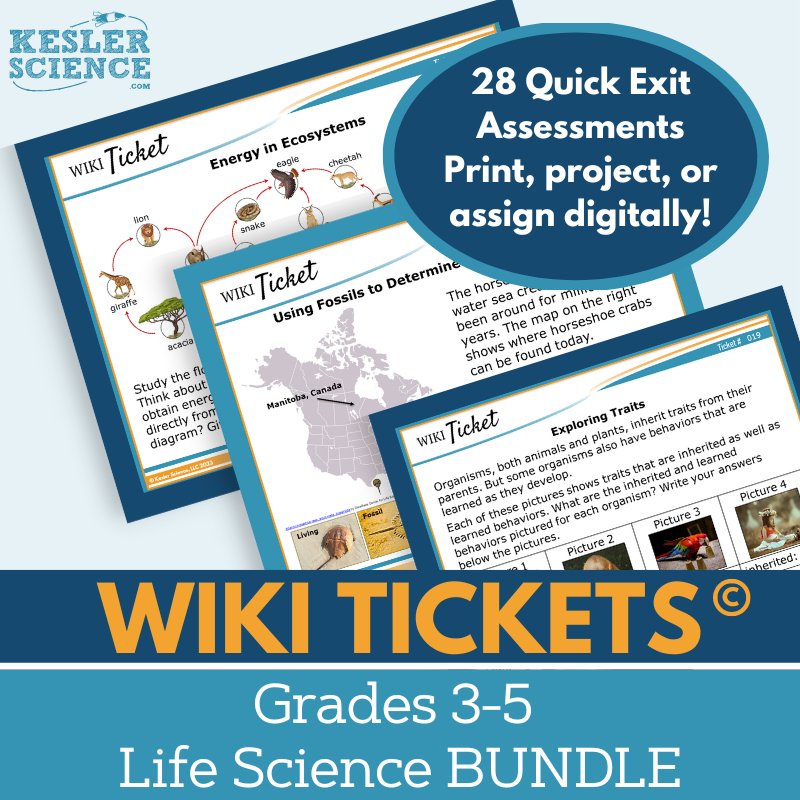Matter & Energy in Food Webs Activities for 4th Grade Science
This engaging 4th-grade life science lesson explores the cycling of matter and energy flow in ecosystems, highlighting the roles of the Sun, producers, consumers, and decomposers. Aligned with the 2021 TEKS 4.12B standard, it follows the 5E Model to build understanding through interactive activities, hands-on station labs, and editable presentations. Students deepen their knowledge with choice projects and demonstrate mastery through STAAR 2.0-aligned assessments. With differentiated, multimodal resources and flexible print or digital formats, this lesson supports diverse learners and includes Spanish translations for key materials. The resources below will give students a comprehensive understanding of food webs. All of the following materials are also included in the Kesler Science Membership.
The Kesler Science Ecosystems 5E Lesson is an engaging life science unit for 4th-grade students, focused on the cycling of matter and flow of energy through food webs, highlighting the roles of the Sun, producers, consumers, and decomposers. This lesson includes editable presentations, worksheets, choice projects, and assessments, with differentiated, student-led activities designed for easy prep and flexible use in print or digital formats. Spanish translations are available for key materials.
Aligned with the 2021 TEKS 4.12B standard, the lesson follows the 5E Model: engaging students with vocabulary and class activities, exploring concepts through a hands-on station lab with multiple learning modalities, and explaining ideas using editable PowerPoints and interactive notebook templates. Students deepen understanding through choice projects and demonstrate mastery with STAAR 2.0-aligned assessments. The materials support diverse learners with multimodal resources, differentiated stations, and flexible formats suitable for in-class or virtual learning.
The Kesler Science Ecosystems 5E Lesson is an engaging life science unit for 4th-grade students, focused on the cycling of matter and flow of energy through food webs, highlighting the roles of the Sun, producers, consumers, and decomposers. This lesson includes editable presentations, worksheets, choice projects, and assessments, with differentiated, student-led activities designed for easy prep and flexible use in print or digital formats. Spanish translations are available for key materials.
Aligned with the 2021 TEKS 4.12B standard, the lesson follows the 5E Model: engaging students with vocabulary and class activities, exploring concepts through a hands-on station lab with multiple learning modalities, and explaining ideas using editable PowerPoints and interactive notebook templates. Students deepen understanding through choice projects and demonstrate mastery with STAAR 2.0-aligned assessments. The materials support diverse learners with multimodal resources, differentiated stations, and flexible formats suitable for in-class or virtual learning.
Engage your 4th-grade students with this student-led station lab aligned with the 2021 TEKS 4.12B standard on energy movement through food chains and food webs. Designed for in-class or virtual learning, this lesson allows students to explore producers, consumers, and decomposers while modeling the flow of energy in ecosystems through nine interactive stations.
Students encounter new concepts by engaging in activities such as hands-on experiments, watching videos, reading passages in English or Spanish, and conducting research with facts, images, and graphs. They demonstrate understanding by organizing information, illustrating food chains, responding to writing prompts, and completing assessments. A bonus challenge station offers extension activities like crosswords, games, and mini-projects for early finishers.
This differentiated, low-prep resource promotes active learning, allowing students to work independently or in small groups while fostering critical thinking and self-directed exploration.
Engage your 4th-grade students with this student-led station lab aligned with the 2021 TEKS 4.12B standard on energy movement through food chains and food webs. Designed for in-class or virtual learning, this lesson allows students to explore producers, consumers, and decomposers while modeling the flow of energy in ecosystems through nine interactive stations.
Students encounter new concepts by engaging in activities such as hands-on experiments, watching videos, reading passages in English or Spanish, and conducting research with facts, images, and graphs. They demonstrate understanding by organizing information, illustrating food chains, responding to writing prompts, and completing assessments. A bonus challenge station offers extension activities like crosswords, games, and mini-projects for early finishers.
This differentiated, low-prep resource promotes active learning, allowing students to work independently or in small groups while fostering critical thinking and self-directed exploration.
The Food Webs, Food Chains, and Food Pyramid Student Choice Projects align with the 2021 TEKS standard 4.12B, offering 4th graders a variety of creative ways to demonstrate their understanding of ecosystems. The project page outlines six student-led options plus a “design your own” project, with an editable rubric for teacher, peer, or self-assessment. This resource is also part of the Matter & Energy in Food Webs Complete Lesson for TEKS 4.12B.
These flexible, multimodal projects allow for personalization and creativity, with a rubric that teachers can adjust to fit grading needs. Two versions of the project page support differentiation—one offers targeted options for students needing remediation, while advanced learners can take on multiple projects using the same rubric.
The resource includes nine project choices plus a customizable option, teacher directions for guidance, and an editable rubric assessing vocabulary, concepts, presentation, clarity, and accuracy. Most projects require only standard classroom supplies like paper, markers, and scissors, though many can also be completed digitally.
The Food Webs, Food Chains, and Food Pyramid Student Choice Projects align with the 2021 TEKS standard 4.12B, offering 4th graders a variety of creative ways to demonstrate their understanding of ecosystems. The project page outlines six student-led options plus a “design your own” project, with an editable rubric for teacher, peer, or self-assessment. This resource is also part of the Matter & Energy in Food Webs Complete Lesson for TEKS 4.12B.
These flexible, multimodal projects allow for personalization and creativity, with a rubric that teachers can adjust to fit grading needs. Two versions of the project page support differentiation—one offers targeted options for students needing remediation, while advanced learners can take on multiple projects using the same rubric.
The resource includes nine project choices plus a customizable option, teacher directions for guidance, and an editable rubric assessing vocabulary, concepts, presentation, clarity, and accuracy. Most projects require only standard classroom supplies like paper, markers, and scissors, though many can also be completed digitally.
The Energy Flow in a Food Web Science and ELA Integrated Writing Activity engages 4th-grade students in creatively exploring how the Sun’s energy moves through a food web. Using a travel brochure format, this activity fosters science reasoning and enriches writing skills, with options for both in-person and virtual learning.
Aligned with TEKS and NGSS standards, this low-prep, student-centered activity works well for elaboration, review, or enrichment. It includes teacher directions with an answer guide, project ideas, and rubrics, along with projection-ready prompts for classroom or virtual sharing. Students receive full-sized and half-sheet handouts featuring prompts, self-checks, pre-writing strategies, and templates, as well as a digital interactive PowerPoint version compatible with Google Slides for flexible learning.
Ideal for cross-curricular activities, pre-test assessments, student choice projects, extra credit, make-up work, TELPAS samples, or differentiation, this activity also makes for an engaging classroom display or student anthology. Designed for review, it assumes students have prior knowledge or access to research materials.
The Energy Flow in a Food Web Science and ELA Integrated Writing Activity engages 4th-grade students in creatively exploring how the Sun’s energy moves through a food web. Using a travel brochure format, this activity fosters science reasoning and enriches writing skills, with options for both in-person and virtual learning.
Aligned with TEKS and NGSS standards, this low-prep, student-centered activity works well for elaboration, review, or enrichment. It includes teacher directions with an answer guide, project ideas, and rubrics, along with projection-ready prompts for classroom or virtual sharing. Students receive full-sized and half-sheet handouts featuring prompts, self-checks, pre-writing strategies, and templates, as well as a digital interactive PowerPoint version compatible with Google Slides for flexible learning.
Ideal for cross-curricular activities, pre-test assessments, student choice projects, extra credit, make-up work, TELPAS samples, or differentiation, this activity also makes for an engaging classroom display or student anthology. Designed for review, it assumes students have prior knowledge or access to research materials.
The WIKI Tickets© formative assessments offer an engaging way to check student understanding in 3rd–5th grade science. This Life Science Set includes 28 assessments, each available in five formats: a full-screen projection version, three printable handout sizes, and an interactive digital version compatible with PowerPoint and Google Slides.
Aligned with NGSS and TEKS standards for upper elementary science, every standard is covered by at least one ticket, with some topics offering multiple options. A bonus table of contents file highlights the standards alignment.
These versatile assessments can be used in both in-person and virtual settings. Topics covered include animal groups for survival, changes in ecosystems, energy flow in food webs, inherited traits, internal and external structures, fossil evidence, and plant growth, among others.
WIKI stands for "What I Know Is." These colorful, flexible assessments can be used as exit tickets, bellringers, or quick checks for understanding. They can be projected, printed, or assigned digitally through PowerPoint or Google Slides, making them adaptable for any classroom environment.
The WIKI Tickets© formative assessments offer an engaging way to check student understanding in 3rd–5th grade science. This Life Science Set includes 28 assessments, each available in five formats: a full-screen projection version, three printable handout sizes, and an interactive digital version compatible with PowerPoint and Google Slides.
Aligned with NGSS and TEKS standards for upper elementary science, every standard is covered by at least one ticket, with some topics offering multiple options. A bonus table of contents file highlights the standards alignment.
These versatile assessments can be used in both in-person and virtual settings. Topics covered include animal groups for survival, changes in ecosystems, energy flow in food webs, inherited traits, internal and external structures, fossil evidence, and plant growth, among others.
WIKI stands for "What I Know Is." These colorful, flexible assessments can be used as exit tickets, bellringers, or quick checks for understanding. They can be projected, printed, or assigned digitally through PowerPoint or Google Slides, making them adaptable for any classroom environment.
Year-Round Resources
These year-round activities will increase your students' understanding of many middle school science topics. All of these activities are also included in the Kesler Science Membership.
Visual Data & Graphing
You're not alone if your students struggle with understanding graphs, charts, and tables. It's a skill that takes an enormous amount of practice. This resource will help students build a strong foundation in analyzing data and creating their own data visualizations.
Bell Ringers and Warm-Ups
These middle school science bell ringers are an excellent way to engage your students as soon as they walk into your classroom. This comprehensive FULL YEAR resource includes everything you need to start off each science class with an interesting warm-up activity.
Review Board Games
Each game board has been carefully designed to keep students engaged. There are 10 different action spaces on each board and dozens of question cards. All of the actions are related to science concepts and keep the students motivated throughout the game.
Each game is ready to play. Simply print out the board and the cards and let the students enjoy reviewing nine different units.
Essential Questions and Standards
Below are the essential questions and standards associated with the lessons and activities included in the atoms unit. This topic is only one of more than 100 middle school science topics included in the Kesler Science Membership.
-
How can we model the flow of energy in an ecosystem?
-
What are the differences between producers, consumers, and decomposers?
-
TEKS Science - 4.12B Matter & Energy in Food Webs
Kesler Science Membership
Imagine never having to search for another middle school science lesson again. The membership gives you access to ALL of the Kesler Science products in one place (Yes, including everything above).
Say goodbye to long hours of lesson prep.











